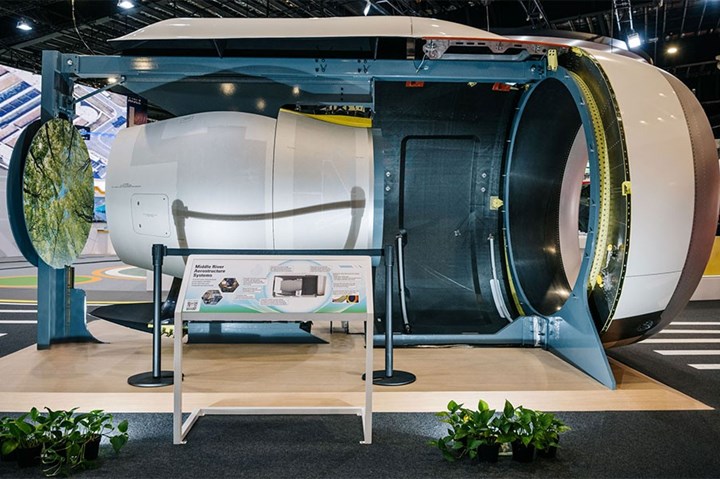Middle River Aerostructure Systems displays aeroengine nacelle using AFP and RTM composites
Highlights technologies and manufacturing processes that enhance aeroengine operating efficiency while reducing fuel consumption and noise.
Share

MRAS’ full-sized nacelle exhibit at the 2022 Singapore Airshow. Photo Credit: Middle Rivers Aerostructure Systems, ST Engineering
Middle River Aerostructure Systems’ (MRAS, Baltimore, Md., U.S.) expertise in developing and producing complex composites-intensive engine nacelles for jet-powered airliners and business jets took center stage at the Singapore Airshow that occurred Feb. 14-18, 2022. Display of the nacelle’s main elements was exhibited by parent company ST Engineering (Singapore) for a complete immersive experience.
The display represented a full-sized nacelle for a typical single-aisle jetliner in the 150-200-seat category, and highlighted many of the design features and production techniques applied by MRAS. This includes the air inlet, which is said to be highly refined aerodynamically to reduce fuel burned, incorporating such features as a single-piece inlet lip skin, a single-piece composite inner acoustic barrel and low-weight composite outer barrel. An outline of the external protection for the jet engine was also noted to attendees, which MRAS says also contributes to its operating efficiency, along with reducing fuel consumption and lowering emissions and noise.
“Being able to walk inside a full-scale nacelle provides a true experience of the size and interrelationship of all elements that come together in this complex component on jet-powered aircraft,” explains Terry Vernes, the director of process engineering and composite operations at MRAS.
MRAS applies advanced manufacturing technologies that contribute to the nacelle’s higher quality and lower weight, including resin transfer molding (RTM), which is used in producing the internal components called “beavertail” fairings, as well as for the blocker doors that are key elements of the nacelle’s thrust reverser. Automated fiber placement (AFP) with industrial robots is applied in the creation of such components as large nacelle transcowls, further reducing cost and weight.
Lowering a jet engine’s overall noise output is contributed by employing precision robotic drilling to create millions of precise, tiny holes within the nacelle’s interior.
Additionally, the nacelle’s composite “thumbnail” fairing will transition to out-of-autoclave (OOA) manufacturing — further reducing energy consumption when compared to the use of autoclaves for the curing process, which is aligned with MRAS’ drive to decrease its carbon footprint.
MRAS produces a full range of nacelle products for jetliners such as the Airbus A320neo and Comac’s (Shanghai, China) C919 (both in partnership with Safran Nacelles, Paris, France), the Comac ARJ21 and Boeing’s (Chicago, Ill., U.S.) 747-8. In the business jet category, MRAS has the lead industrial role in the Passport integrated propulsion system on Bombardier’s (Montreal, Canada) Global 7500, which is supplied via the Nexcelle joint venture. The company also enlarged its maintenance, repair and overhaul (MRO) capabilities for jet engine nacelles in Oct. 2021.
Related Content
-
The potential for thermoplastic composite nacelles
Collins Aerospace draws on global team, decades of experience to demonstrate large, curved AFP and welded structures for the next generation of aircraft.
-
Plant tour: Joby Aviation, Marina, Calif., U.S.
As the advanced air mobility market begins to take shape, market leader Joby Aviation works to industrialize composites manufacturing for its first-generation, composites-intensive, all-electric air taxi.
-
Combining multifunctional thermoplastic composites, additive manufacturing for next-gen airframe structures
The DOMMINIO project combines AFP with 3D printed gyroid cores, embedded SHM sensors and smart materials for induction-driven disassembly of parts at end of life.
















